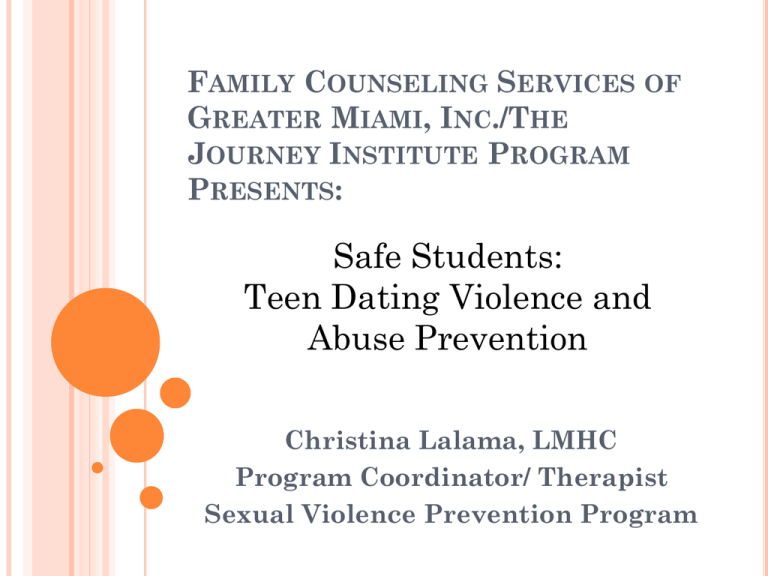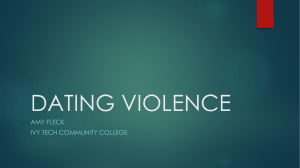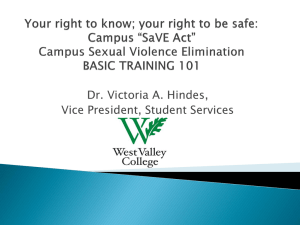
FAMILY COUNSELING SERVICES OF
GREATER MIAMI, INC./THE
JOURNEY INSTITUTE PROGRAM
PRESENTS:
Safe Students:
Teen Dating Violence and
Abuse Prevention
Christina Lalama, LMHC
Program Coordinator/ Therapist
Sexual Violence Prevention Program
WHY IS PREVENTING TEEN DATING
VIOLENCE IMPORTANT?
72% of 8th and 9th graders “date”
It is important that teens recognize and
understand what constitutes a healthy
relationship.
The lessons teens learn today about respect,
healthy vs. unhealthy relationships, and what is
right or wrong may carry over into future
relationships.
Relationships that occur in the teen years may
affect dating relationships later in life.
Several studies suggest that adolescents do not
see the negative consequences of dating violence
in their friends' lives.
In one study, 31% of adolescents reported having
at least one friend who was in a violent
relationship.
Acceptance of dating violence among friends is
one of the strongest links to being involved in
future dating violence.
Qualities like respect, good communication, and
honesty are requirements for a healthy
relationship. Adolescents who do not recognize
these qualities in relationships before they begin
to date may have trouble forming healthy,
nonviolent relationships with others.
FACTS
In a nationwide survey of students in grades 912, nearly one in 10 students reported being hit
or physically hurt on purpose by a boyfriend or
girlfriend at least once in the past 12 months.
About one in four teens reports verbal, physical,
emotional, or sexual violence each year
About one in five high school girls has been
physically or sexually abused by a dating
partner.
Adolescents who are victims of dating violence
not only are at increased risk for injury, but are
also more likely to report binge drinking, suicide
attempts, physical fighting, and sexual activity.
Approximately 8% of boys and 9% of girls have
been to an emergency room for an injury received
from a dating partner.
About 70% of girls and 52% of boys who are
victims of dating violence report an injury from a
violent relationship.
About 72% of students in 8th and 9th grade
report "dating."1 By the time they are in high
school, 54% of students report dating violence
among their peers.
About one in five teens reports being a victim of
emotional abuse.6
CONSEQUENCES OF TEEN DATING
VIOLENCE
Dating violence is associated with unhealthy
sexual behaviors that can lead to unintended
pregnancies, sexually transmitted diseases, and
HIV infections.
Rates of drug, alcohol, and tobacco use are more
than twice as high in girls who report physical
dating violence or sexual abuse than in girls who
report no violence.
Bruises, scratches, or other injuries
Missed classes, poor grades, or avoidance of
school or social events
Lying to or withdrawing from friends and/or
family
Low self-esteem
Feelings of loneliness or isolation
Depression
Suicide attempts
Drug and alcohol abuse
Risky sexual behavior
Medical problems
Inability to succeed in school or at work later in
life
EXAMPLES OF VIOLENCE AND ABUSE
Verbal & Emotional Abuse
Sexual Violence
Name-calling, shouting, teasing, or
bullying
Use of intimidation
Use of demeaning or derogatory
language
Insults or rumors
Threats or accusations
Jealousy or possessiveness
Humiliation
Withdrawal of attention
Withholding of information
Deliberately doing something to make
a dating partner feel diminished or
embarrassed
Controlling behavior, such as dictating
what a dating partner can wear
Isolation from friends and family
Texting or instant messaging
excessively
Monitoring e-mail or a profile on a
social networking site
Unwanted touching, fondling, or
groping
Forced sexual activities
Pressure to have sex
Violence that does not involve physical
contact
Threatening to find someone who
will do what he or she wants
sexually
Verbal or sexual harassment
Threats of sexual violence
Physical Violence
Pinching
Shoving
Hitting or slapping
Grabbing
Kicking
Throwing
Shaking
Choking
WARNING SIGNS
Perpetrated
Suspicious bruises, scratches, or
other injuries
Failing grades
Loss of interest in activities or
hobbies that were once enjoyable
Alcohol or drug use
Excuses their dating partner's
behavior
Fearfulness around their dating
partner or when his or her name is
mentioned
Avoidance of friends and social
events
Perpetrator
Threatens to hurt others in any way
Insults or ignores a dating partner
in public or private
Constantly calls or texts to check up
on a dating partner
Damages or destroys a dating
partner's personal belongings
Attempts to control a dating
partner's friends, their activities, or
even the clothes they wear
Exhibits jealous and possessive
behavior
Demands to know where their
dating partner is all the time
Making a dating partner feel guilty
or shameful with statements such
as: "If you really loved me, you
would..."
Blames the dating partner for his or
her feelings and actions with
statements such as: "You asked for
it" or "You made me mad"
TIPS FOR EDUCATORS
Keep an open environment. Be available to listen to your
students. Give them opportunities to start talking and do not
to criticize them for having questions.
Give your student your undivided attention. Focus your
attention on the conversation and your student. Do not let
other things distract you or divide your concentration; if it is
really a bad time to talk, schedule and keep another
appointment where you can talk, but first make sure that
waiting is okay with the teen.
Connect frequently. Follow up with your students on a
regular basis; it lets your students know you are interested in
their lives. Especially true if a student has already confided in
you about something.
Understand the questions and respond genuinely. If you
are not sure what the student is asking, say so. Once you
understand the question, respond genuinely and assure him or
her that you take his or her concerns seriously. As a trusted
adult in the students' lives, the teacher can connect students
with other resources they can access for help.
Practice what you preach—Respect, listening, etc.
CONTACT INFORMATION
Family Counseling ServicesThe Journey Institute
305-740-8998
www.familycounseling.org
Presenter:
Christina Lalama, LMHC
305-740-8998 ext. 104
clalama@familycounseling.org
preventviolence@familycounseling.org








